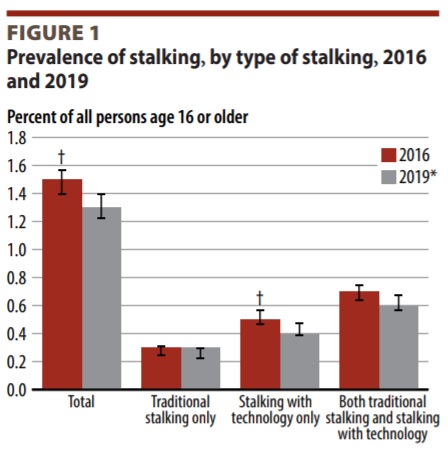
Millions Of Americans Are Victims Of Stalking Each Year
By a Biometrica staffer
An estimated 3.4 million U.S. residents aged 16 or older were victims of stalking in 2019, the Bureau of Justice Statistics (BJS) said in its Stalking Victimization report published this month. That estimated number amounts to around 1.3% of all U.S. residents aged or older falling prey to stalking in 2019, the latest year for which the BJS has data available. Statistically, 2019’s 1.3% is a significant decrease from 2016’s 1.5%, the BJS said.
However, the decline is largely due to a reduction in a subset of stalking as measured by BJS: stalking with technology. The number of stalking with technology victims fell to 1.1 million in 2019 from 1.3 million victims in 2016. In comparison, though, the number of victims of traditional stalking only or both traditional and technology stalking did not change significantly during this period.
The BJS report’s findings are based on the 2019 Supplemental Victimization Survey (SVS) to the National Crime Victimization Survey. In this piece, we first take a look at what constitutes stalking, how the BJS defines it, and examine a few key highlights of the report.
Stalking: Definition and classification
Per the BJS, “stalking includes repeated unwanted contacts or behaviors that caused the victim to experience fear or substantial emotional distress or would cause a reasonable person to experience fear or substantial emotional distress.” How does the BJS report classify someone as a victim of stalking?
It says, to be classified as a victim of stalking in the SVS, the respondent must have experienced a repeated course of conduct (i.e., experienced the same behavior or contact more than once or experienced two or more different behaviors one time) that either —
- caused them substantial emotional distress or to fear for their safety or the safety of someone they know (actual fear)
- would cause a reasonable person to fear for their safety or the safety of someone they know
What does reasonable fear mean here? Per the BJS report, it includes victimizations where the victim reported that they experienced either —
- damage, attempted damage, or destruction of property
- threatened, attempted, or completed attacks on the victim, someone close to them, or a pet

Under stalking, the SVS measured 12 types of stalking behaviors, incorporating both traditional stalking and stalking with technology. Traditional stalking, the report says, includes the following:
- following and watching
- sneaking into a place
- waiting at a place
- showing up at a place
- leaving or sending unwanted items
- harassing friends or family about the victim’s whereabouts
Stalking with technology includes the following unwanted behaviors:
- making unwanted phone calls, leaving voice messages, or sending text messages
- spying using technology
- tracking the victim’s whereabouts with an electronic tracking device or application
- posting or threatening to post unwanted information on the Internet
- sending unwanted emails or messages using the Internet
- monitoring activities using social media
Select highlights from the report
- Most (67%) stalking victims knew their stalker
- In 2019, females (1.8%) were stalked more than twice as often as males (0.8%)
- Less than a third (29%) of all stalking victims reported the victimization to police in 2019
- An estimated 67% of victims of both traditional stalking and stalking with technology were fearful of being killed or physically harmed
- Victims of both types of stalking in 2019 were more likely to be stalked by an intimate partner (35%) than victims of only traditional stalking (11%) or only stalking with technology (18%)
- Victims of both stalking types were more than twice as likely to have applied for a restraining, protection, or no-contact order as victims of traditional or technology stalking only
- In 2019, about 16% of all stalking victims sought victim services and 74% of the victims who sought services received them
- Two-thirds of victims of stalking with technology received unwanted phone calls, voice messages, or text messages in 2019
- The most frequently reported traditional stalking behaviors in 2019 included the offender following and watching the victim (58%) or showing up at, riding by, or driving by places where the offender had no business being (49%)
- Nearly 42% of victims of traditional stalking said the offender harassed their friends or family for information on their whereabouts
- Almost a third (31%) of traditional stalking victims said the offender waited for them at home, school, or another place. More than a fifth (22%) said the offender left or sent unwanted items. In 2019, less than a fifth (17%) of victims said that the offender snuck into their home, car, or another place to let them know the offender had been there
- Stalking with technology victims most commonly received unwanted phone calls, voice messages, or text messages (66%) in 2019, followed by unwanted emails or messages via the Internet (55%). About 32% o victims of this type of stalking said their activities were monitored using social media. Twenty-nine percent experienced the offender posting or threatening to post inappropriate, unwanted, or personal information about them on the Internet
- Twenty-two percent of stalking with technology victims said the offender spied on them or monitored their activities using technologies such as listening devices, cameras, or computer or cellphone monitoring software. About 14% were tracked with an electronic tracking device or application